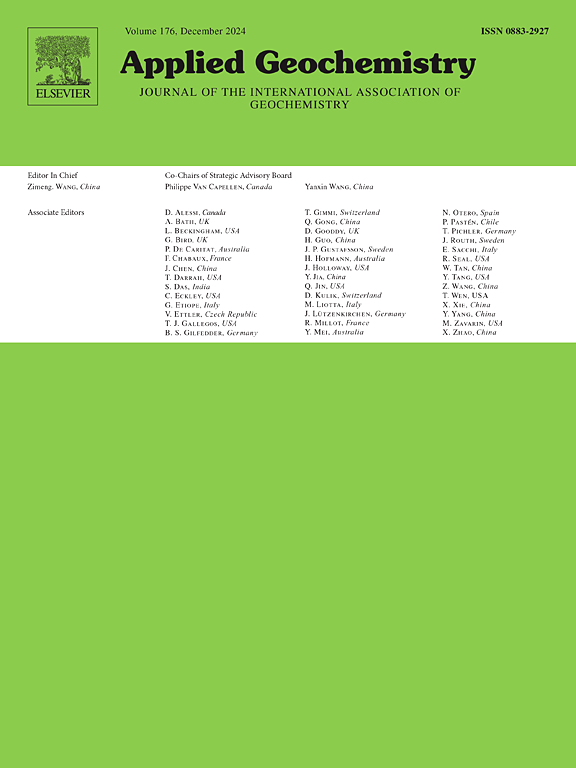Radiometric dating and biodegradation assessment of Light Non-Aqueous Phase Liquids (LNAPL): Results from two case studies
IF 3.4
3区 地球科学
Q1 GEOCHEMISTRY & GEOPHYSICS
引用次数: 0
Abstract
This study introduces a comprehensive methodology that integrates radiometric dating with gas chromatographic (GC) analyses of light non-aqueous phase liquids (LNAPL) recovered from monitoring wells at different filling stations. The aim is to evaluate the temporal evolution of LNAPLs in two distinct scenarios: natural attenuation (at site 1) and ongoing remediation activities (at site 2). The study period spans one year and four months, from June 2020 to October 2021. Throughout this time frame, the study monitored the progress of petroleum hydrocarbon biodegradation by analysing selected compounds: Total Petroleum Hydrocarbons (TPH), Σ n-alkanes (C13 to C18), Σ isoprenoids (C15 to C20), C17/Pristane and C18/Phytane ratios, and a specific biodegradation diagnostic index. The age determination provided reliable results for a single-point model release scenario (site 1). However, at site 2, where multiple LNAPL spills occurred, the age determination resulted in only an apparent age, due to the mixing of different fluids. Nevertheless, the unlike spatial distribution of the fluids offers some chances to estimate the age of the end members. The trend of the biodegradation in LNAPLs recovered from the two sites seems similar, pointing to a nearly complete removal of isoprenoids, independent of the initial values and whether or not there is an active remediation process. The main difference between the sites is the apparent tendency to the reduction of the heaviest (TPH) and more persistent compounds (such as pristane and phytane), probably triggered by the electrokinetic oxidation system taking place in the second site. The importance of these initial experimental findings lies in their ability to evaluate the site-specific response to pollutants, thereby enhancing the effectiveness of remediation efforts over time.

光非水相液体(LNAPL)的放射性测年和生物降解评价:来自两个案例研究的结果
本研究介绍了一种综合的方法,该方法将辐射定年法与气相色谱(GC)分析相结合,分析从不同加油站的监测井中回收的轻质非水相液体(LNAPL)。目的是评估LNAPLs在两种不同情景下的时间演变:自然衰减(在站点1)和正在进行的修复活动(在站点2)。研究时间为一年零四个月,从2020年6月到2021年10月。在此期间,该研究通过分析选定的化合物来监测石油烃生物降解的进展:总石油烃(TPH), Σ正烷烃(C13至C18), Σ类异戊二烯(C15至C20), C17/Pristane和C18/Phytane比率,以及特定的生物降解诊断指数。年龄测定为单点模型泄漏情景(站点1)提供了可靠的结果。然而,在站点2,发生了多次LNAPL泄漏,由于混合了不同的流体,年龄测定只得出了表面年龄。然而,流体的不同空间分布提供了一些估计端部年龄的机会。从两个地点恢复的LNAPLs的生物降解趋势似乎相似,指向几乎完全去除类异戊二烯,与初始值无关,也与是否存在主动修复过程无关。这两个位点之间的主要区别在于,它们明显倾向于还原最重的(TPH)和更持久的化合物(如酞烷和植烷),这可能是由发生在第二个位点的电动氧化系统触发的。这些初步实验结果的重要性在于它们能够评估特定地点对污染物的反应,从而随着时间的推移提高修复工作的有效性。
本文章由计算机程序翻译,如有差异,请以英文原文为准。
求助全文
约1分钟内获得全文
求助全文
来源期刊

Applied Geochemistry
地学-地球化学与地球物理
CiteScore
6.10
自引率
8.80%
发文量
272
审稿时长
65 days
期刊介绍:
Applied Geochemistry is an international journal devoted to publication of original research papers, rapid research communications and selected review papers in geochemistry and urban geochemistry which have some practical application to an aspect of human endeavour, such as the preservation of the environment, health, waste disposal and the search for resources. Papers on applications of inorganic, organic and isotope geochemistry and geochemical processes are therefore welcome provided they meet the main criterion. Spatial and temporal monitoring case studies are only of interest to our international readership if they present new ideas of broad application.
Topics covered include: (1) Environmental geochemistry (including natural and anthropogenic aspects, and protection and remediation strategies); (2) Hydrogeochemistry (surface and groundwater); (3) Medical (urban) geochemistry; (4) The search for energy resources (in particular unconventional oil and gas or emerging metal resources); (5) Energy exploitation (in particular geothermal energy and CCS); (6) Upgrading of energy and mineral resources where there is a direct geochemical application; and (7) Waste disposal, including nuclear waste disposal.
 求助内容:
求助内容: 应助结果提醒方式:
应助结果提醒方式:


